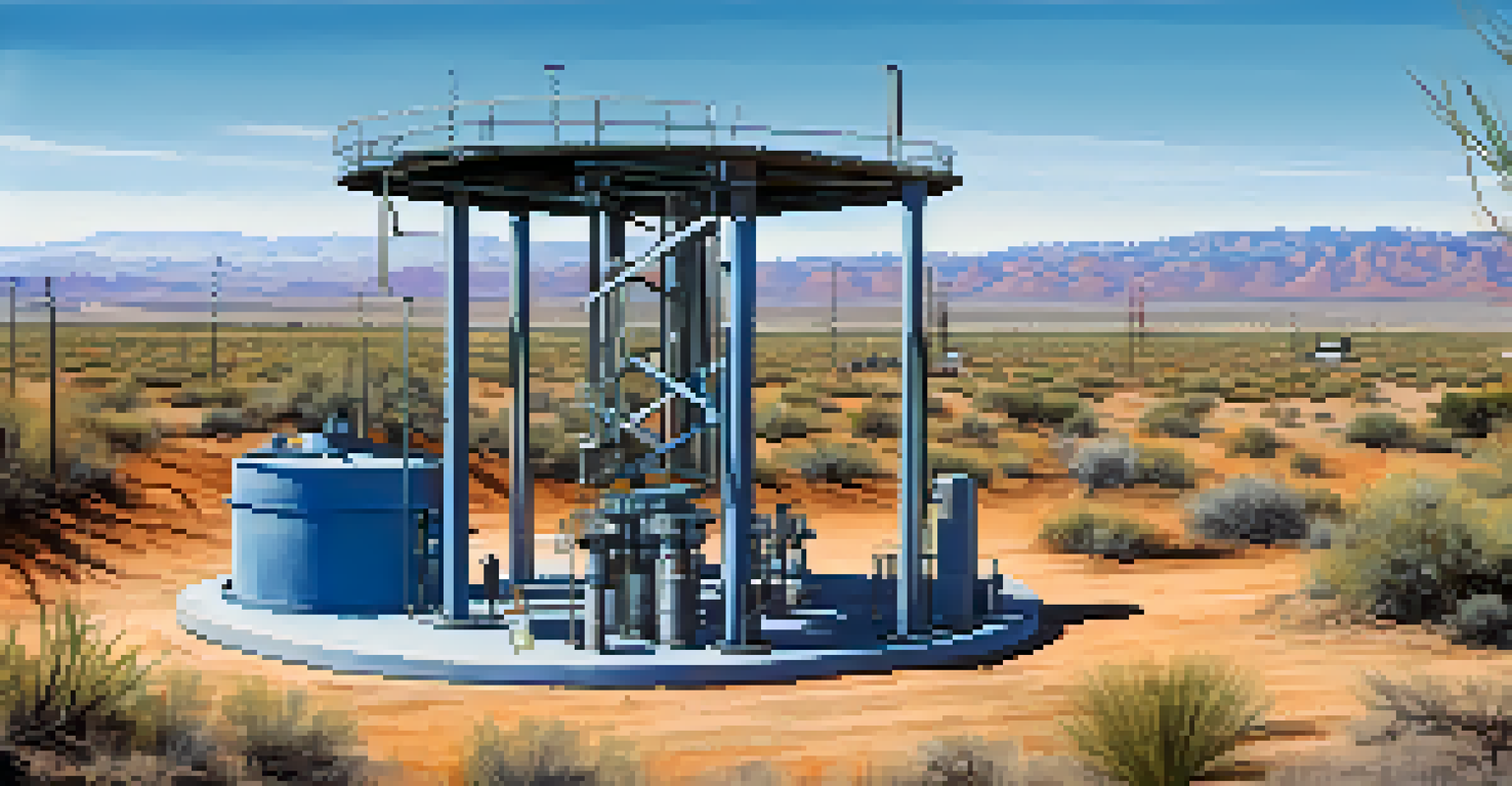Evaluating Aquifer Recharge Techniques in Arizona

Understanding Aquifers: The Heart of Arizona's Water Supply
Aquifers are underground layers of water-bearing rock that store and transmit water. In Arizona, they are crucial for supplying drinking water and irrigation, especially in arid regions. Understanding how these systems work helps us appreciate the importance of aquifer recharge techniques.
Water is the driving force of all nature.
With the state's growing population and increasing drought conditions, the demand for sustainable water sources is at an all-time high. This situation necessitates innovative methods to replenish aquifers, ensuring that this essential resource remains accessible for future generations. Through effective management, we can help balance the water supply and demand.
Aquifer recharge techniques can include various methods, such as surface spreading, injection wells, and stormwater capture. Each technique has its unique benefits and challenges, which we will explore in depth throughout this article.
The Importance of Aquifer Recharge in Arizona's Climate
Arizona's climate is characterized by low rainfall and high evaporation rates, making water scarcity a pressing concern. Aquifer recharge plays a vital role in mitigating this issue by replenishing groundwater supplies during wetter periods. This process not only supports the water supply but also enhances ecosystem resilience.

Moreover, the unpredictability of rainfall patterns due to climate change further emphasizes the need for effective recharge strategies. By investing in these techniques, Arizona can create a more sustainable water future, reducing reliance on surface water and imported supplies. It's a proactive approach to managing a precious resource.
Aquifers are vital for Arizona's water
Aquifers serve as essential underground water sources, crucial for drinking and irrigation, especially in Arizona's arid climate.
Incorporating aquifer recharge into water management plans is essential for long-term sustainability. As we face more frequent droughts and population growth, these strategies will become increasingly important in ensuring water availability for all sectors, including agriculture, industry, and households.
Surface Spreading: A Natural Approach to Recharge
Surface spreading involves directing water into basins where it can infiltrate the ground, replenishing aquifers naturally. This technique uses existing landscapes to facilitate the recharge process, making it a cost-effective and environmentally friendly option. In Arizona, surface spreading is often used with treated wastewater or stormwater runoff.
We never know the worth of water till the well is dry.
The success of surface spreading relies on several factors, including soil type, basin design, and local climate conditions. In some areas, sandy soils allow for faster infiltration, while clay soils may require larger basins to hold water long enough for recharge. Understanding these dynamics is crucial for optimizing this method's effectiveness.
Additionally, surface spreading can enhance local ecosystems, providing habitats for wildlife and increasing vegetation. However, it requires careful management to ensure that water quality is maintained and that the recharge process does not lead to unintended consequences.
Injection Wells: A Direct Method for Aquifer Recharge
Injection wells are another technique for aquifer recharge, allowing water to be pumped directly into the aquifer through a well. This method can be particularly effective in areas where surface spreading is not feasible, such as urban environments or regions with limited land availability. Injection wells can quickly replenish aquifers, making them a valuable tool in water management.
One of the main advantages of injection wells is their ability to control the recharge process more precisely. Operators can monitor water quality and flow rates, ensuring that only suitable water is introduced into the aquifer. However, this method also comes with challenges, such as the risk of aquifer contamination if not managed properly.
Recharge methods ensure water sustainability
Innovative aquifer recharge techniques like surface spreading, injection wells, and stormwater capture are vital for maintaining water supplies amid growing demands.
Additionally, the construction and maintenance of injection wells can be costly and require extensive permits. Therefore, while they offer a direct approach to aquifer recharge, careful consideration and planning are essential to ensure their effectiveness and safety.
Stormwater Capture: Turning Rainfall into a Resource
Stormwater capture is an innovative approach that involves collecting and managing runoff from rainfall events. Instead of allowing this water to flow into drainage systems, it can be redirected to recharge aquifers. This technique not only helps replenish groundwater but also reduces urban flooding and erosion.
In Arizona, stormwater capture can be particularly beneficial in urban areas where impervious surfaces prevent water infiltration. By creating green infrastructure, such as rain gardens and permeable pavements, cities can enhance their resilience to storms while promoting groundwater recharge. This method turns a potential problem into a valuable resource.
Moreover, stormwater capture systems can be designed to filter pollutants before they reach the aquifer, ensuring that only clean water is reintroduced. This dual benefit makes stormwater capture a win-win solution for both water management and environmental health.
Evaluating the Effectiveness of Recharge Techniques
Evaluating the effectiveness of various aquifer recharge techniques is essential for informed decision-making. Key performance indicators, such as infiltration rates, water quality, and cost-effectiveness, must be assessed to determine which methods are most suitable for specific regions. This evaluation helps ensure that resources are used efficiently.
Field studies and modeling can provide valuable data on how different recharge techniques perform under varying conditions. By understanding the strengths and weaknesses of each method, policymakers can tailor their approaches to meet local needs. This adaptability is crucial in a state like Arizona, where conditions can vary widely across regions.
Challenges hinder effective implementation
Funding issues, regulatory barriers, and public perception pose significant challenges to the successful implementation of aquifer recharge strategies in Arizona.
Additionally, public engagement and stakeholder collaboration can enhance the evaluation process. Involving community members, businesses, and environmental groups fosters a shared understanding of water challenges and encourages support for effective recharge initiatives.
Challenges and Future Directions for Aquifer Recharge
Despite the potential benefits of aquifer recharge techniques, challenges abound. Issues such as funding constraints, regulatory hurdles, and public perception can hinder the implementation of effective strategies. Addressing these challenges requires a concerted effort from stakeholders at all levels.
Furthermore, as climate change continues to impact water availability, innovative solutions must be explored. Research into new technologies and methods can help optimize aquifer recharge processes and improve water quality. By embracing a proactive approach, Arizona can adapt to changing conditions and ensure long-term water security.

Looking ahead, collaboration between government agencies, researchers, and local communities will be essential for advancing aquifer recharge initiatives. By working together, Arizona can harness the collective knowledge and resources needed to develop sustainable strategies that benefit both people and the environment.